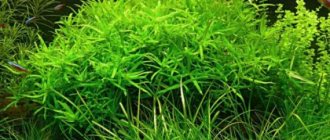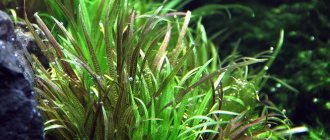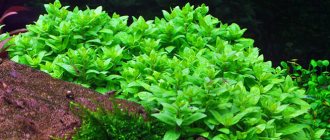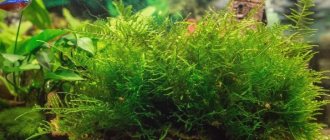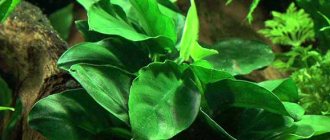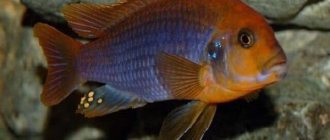This plant belongs to the Araceae family. The small Indonesian island of Sumatra is considered to be the homeland of Cryptocoryne pontederifolia . This unique name for the plant appeared due to its leaf shape, which strongly resembles the leaves of another tropical plant - pontederia. Not long ago, Cryptocoryne pontederifolia gained considerable popularity and fame among aquarists, both amateurs and professionals.
Content
- 1 Description
- 2 Features
- 3 Recommendations
- 4 Reproduction
Source: images.aquaria.net
Source: acquariofiliaconsapevole.it
- Other names: Cryptocoryne pontederiifolia, C. sulphurea de Wit..
- Origin: Southeast Asia, Sumatra island.
- Size: 20-25 cm.
- Temperature: 22-28 °C.
- Water parameters: pH 6.5–7.5, dKH 6–20 °.
- Lighting: from 0.2 to 0.4 W/l.
- Growth rate: slow.
- Content difficulty: easy.
Other species of the genus Cryptocoryne
- Cryptocoryne Balance
- Cryptocoryne Beckett
- Cryptocoryne Blassa
- Cryptocoryne Wendt
- Griffith's Cryptocoryne
- Cryptocoryne Neville
- Cryptocoryne Poetsch
- Cryptocoryne aponogenolifolia
- Cryptocoryne splendor
- Cryptocoryne yellow
- Cryptocoryne reverse spiral
- Cryptocoryne purpurea or red-flowered
- Cryptocoryne ciliata or Cryptocoryne ciliata
- Cryptocoryne related
- Cryptocoryne cordata or Cryptocoryne cordata
- Cryptocoryne siamese
- Cryptocoryne ligulate
Description
Cryptocoryne pontederifolia is native to the island of Sumatra. The plant got its name due to its resemblance to the tropical plant Pontederia. This plant is very popular among aquarists. Cryptocoryne pontederifolia is a marsh plant that takes root in the ground. The leaf blade is lanceolate to narrowly ovate, 9–14 cm long, 3–8 cm wide, smooth or slightly vesicular, light to olive green in color, sometimes brownish or pale purple. The apex is pointed; the base is usually heart-shaped. The spathe is 4-7 cm long. The tube is up to 0.5 cm long. The spathe plate is 1.5-5 cm, elongated-pointed, erect or bent, slightly twisted, from rough to slightly wrinkled, yellow or reddish on the inside. The collar area is wide, smooth to slightly rough, and the color is the same as that of the leaf. There are 5-6 female flowers. There are 20-35 male flowers. Number of chromosomes 2n = 30.
Cryptocoryne pontederifolia
Cryptocoryne pontederifolia photo
Range - Sumatra island.
Cryptocoryne pontederiifolia is a plant, a popular representative of its genus. The plant got its name because of the shape of the leaves - reminiscent of the tropical plant pontederia. The leaves are heart-shaped, light greenish in color. Plant size is 20-25 cm. It grows evenly throughout the year.
Moderately whimsical and quite popular aquarium plant.
Cryptocoryne pontederifolia photo
Genus: Cryptocoryne
Family: Araceae
Habitat: freshwater plant of the island of Sumatra.
Appearance: herbaceous bush, without stem. The leaves of Cryptocoryne are wide, heart-shaped, pointed at the tip, united by a rosette. The leaf blade is light green on the outside, and red-pink on the inside with veins. The leaves are much shorter than the petioles. The height of the bush is 20-25 cm.
Root system: well developed, represented by a horizontal rhizome.
Cryptocoryne pontederifolia photo
Soil: nutritious, rich in organic matter, with the addition of a substrate or udo tablets. Soil thickness is 6-7 cm. During the period of active growth, it is advisable to feed the plant with nitrogen fertilizers.
Lighting: bright. Moderate lighting is allowed, but the plant will lose its decorative effect, the leaves of cryptocoryne will be pale and curled. The best option for lighting: an LB fluorescent lamp in combination with LED lamps, the total power of which should be 80-100 Lm/l of water. Daylight hours are 8-12 hours.
Water parameters for keeping Cryptocoryne pontederifolia:
Comfortable temperature: 22-28 °C.
“Acidity” Ph: 6.5-7.5.
Hardness dКH: 6–20 °.
It is necessary to monitor the acidity level of the water, as the plant is susceptible to “cryptocoryne disease”.
Placement in the aquarium: Cryptocoryne pontederifolia should be provided in a tropical aquarium and it is better to place it in the middle of the pond.
Reproduction: vegetative, by rhizome layering.
Cryptocoryne pontederifolia is a plant that prefers marshy areas, so it does well in a humid greenhouse and tropical paludarium.
We recommend that you read the full and extensive article about CRYPTOCORYNES!
Cool videos about plants from FanFishki
Subscribe to our YouTube channel so you don't miss anything
PRACTICAL NOTE ON GROWING AQUARIUM PLANTS
This note is posted in all FanFishka articles dedicated to aquarium plants. This is a cheat sheet with a link that will help you grow any aquarium plant and herbalist of any complexity.
Most of the reference materials are located in the Aquascape , we also recommend our brochure: Aquarium navigator for beginners: “Underwater Gardens of Babylon” .
The formula for success in growing plants can be depicted as follows.
First of all, the proper level of lighting is necessary.
(light intensity - Lumens)
Next, the proper concentration of CO2
Further macro-fertilizers and micro-fertilizers
Water parameters, care and quality water changes
The gradation of this formula is based on the degree of importance. Lighting intensity is primary, and then descending. Therefore, if your plants have holes in the leaves, they have sciatica (crooked) or there are problems with algae, then please do not read the “bad advice” - this is chlorosis (lack of iron), this is a lack of potassium... diarrhea, phimosis and endometriosis )
You always need to solve the problem of setting up an herbalist from major to minor. Plants will die more quickly from a lack of lighting than from a lack of Fe and K. Moreover, the latter are always present in one degree or another in the aquarium, but it is difficult to measure their precise value.
Below, let's go from the main to the minor.
Lighting in an aquarium with plants . Remember, the most important thing in light is its intensity (Lumens)! All other lighting characteristics: spectrum, Kelvin, PAR/PAR, Ra... are important, but secondary. There will be no intensity of lighting, there will be nothing. At the same time, the lighting intensity must be balanced - selected specifically for your project (height of the water column, number and types of plants, daylight hours).
Based on the above, choose aquarium lighting primarily by the number of lumens, and then everything else.
Lighting is the most expensive part. The most budget-friendly solution is to install ordinary construction-street floodlights above the aquarium . Fortunately, they are now very thin and aesthetic. And believe me, under them everything grows with a bang, of course, provided that all the other components are present.
In order not to be unfounded, here are photos of our herbalists, which were grown exclusively under LED spotlights or with their presence.
If you want professional lighting or aesthetics. Then you will have to fork out some money. The amounts can vary quickly from 10,000 to 50,000+ rubles for a 100 liter aquarium. For example, in 2021 we switched to professional lighting - ISTA Titan . Yes, not cheap, but the lamps are Achon! We have grown a professional competitive aquascape under them. That’s why we advise you to pay attention to them.
Well, it’s difficult to advise anything, because... Everyone has different needs and capabilities. In this article we talk about the products of our partners - Tetra , Laguna , ISTA lighting .
We tried to briefly and objectively talk about them. Then it's up to you. In any case, we do not really recommend that you pay attention to handicraft lighting assembly from folk craftsmen. Not all, but as a rule, they shove who knows what kind of diodes into such an assembly, assemble it all on their knees... and believe me, more than once on the forum you hear echoes of the consequences of such a purchase. After all, a company is a company. At a minimum, you are given warranty and post-warranty service.
If you are a beginner, your first herbalist, then LED spotlights are your choice. Let's move on, otherwise this note isn't very short =)
CO2 for aquarium plants . The plant is approximately 90% water, the remaining 10% is dry matter. Of that 10%, 46% is carbon. This is why CO2 supply is so important in a planted aquarium.
Plants in an aquarium obtain carbon “from water” - from carbon-containing compounds. But the natural concentration of C-carbon in water is small and is only sufficient for unpretentious plants, but they, and even more so, will be happy with additional carbon feeding. The supply of CO2 can be provided using mash or a CO2 balloon system , lemon juice or other methods.
The best, professional, simple and budget option is to supply carbon dioxide through a cylinder. One thing, however, is the initial purchase of a set: a cylinder, an MG valve, a diffuser…. will hit the budget.
Is it possible to do without CO2, but for a couple of bushes of simple plants ( cryptocorynes , echinodorus , most ludwigias , etc.).
What balloon systems can you recommend? The most budget option is an assembly from craftsmen who sell CO2 systems in VK and on forums. Everything is very high quality.
If you want a branded item, then we recommend the most inexpensive and at the same time high-quality CO2 systems from ISTA (Taiwan) . We have been using them for 5 years and recommend them to you.
On sale you will find two series of ISTA Aluminum CO2 Cylinder cylinders, with horizontal and vertical threads of 1 and 3 liters.
Fertilizers for an aquarium with plants . All fertilizers, of any brand, can be divided into MACRO-FERTILIZERS and MICRO-FERTILIZERS .
Macro fertilizers are nitrate NO3 and phosphate PO4 from which plants take N-nitrogen and P-phosphorus. These are the most important elements after CO2 - C-carbon.
Remember - Redfield's proportion rules . Always keep it under control and everything will be ok. Right, based on our observations, Redfield’s proportion rules only in full NPC proportions. Incomplete proportion - without carbon C does not give good results.
Micro fertilizers . These are all the other less important elements that are necessary for plants (see link). There is no point in putting too much emphasis on them. Firstly, all of them are contained in one quantity or another in tap water and are restored in the aquarium with changes. Secondly, an overdose of micro very quickly leads to an outbreak of algae.
A common mistake made by beginners is not understanding what they are pouring into the aquarium. For example, let's take such a popular and popular fertilizer as Tetra PlantaMin . Read the product summary at the link - it strengthens, stimulates, and gives a chic body shape.
A beginner, without delving into the essence, uses it and gets an outbreak of algae, writes on the forums - “Like, wow, what a bad Tetra.” And the trouble lies not in the drug, but in a lack of understanding of the nitrogen cycle and balance in the herbalist . The beginner has a Redfield bias (let’s say N and P are generally zero) and instead of making up for the lack of these primary elements, he fills the aquarium with Tetra PlantaMin - a micro-fertilizer (iron, potassium, manganese). As a result, going over the micro is only detrimental, because... plants lack the base - nitrogen and phosphorus.
Thus, you must understand what plants lack and understand fertilizers.
How to understand what plants lack? It's simple. Now the market is filled with a variety of expensive and not so expensive aquarium water tests. We recommend inexpensive domestic ones - VladOx drop tests , they are sold online and offline.
We also recommend, let’s not be afraid of this word, innovative domestic UHE tests . They are currently only sold online.
The minimum set of tests for an herbalist is NO3 and PO4. It is advisable to have the entire nitrogen range: NH4, NO2, NO3. As well as kH and pH tests.
Tests help us monitor the situation in the herbalist, but over time it is advisable to learn to see and feel the aquarium for yourself. With experience you need to move away from “convulsive testing”; the best aquarium test and tool is ourselves.
Let's summarize this part. Macro, it’s macro in Africa too. The link above generally contains a recipe on how to make them yourself. If you are not yet ready for self-mixing, then always and everywhere you will find a line of fertilizers from Tetra: Tetra Planta Macro , Tetra PlantaMicro , substrates, root tablets and much more .
Of course, there are many other brands that produce aquarium fertilizers. There is an opportunity, use even ADA products. All markers are different in taste and color. The main thing is to use it with a clear understanding of what you are using it for and what you want to get in the end.
From the professional line of fertilizers, at an adequate price, we can recommend Prodibo (soils, soils, macro, micro, stimulants, etc.).
So, something like a note turns into the Talmud. Which is not surprising - the topic is very broad. One moment left.
Water parameters for aquarium plants. Link1 and Link2 , please look at these articles, they cover the essence quite well.
Here we note that the quality of photosynthesis is influenced by the process of caring for the aquarium: water parameters (kH, pH below 7), high-quality filtration and aeration, competent and timely water changes.
Please study
Peculiarities
Cryptocoryne pontederifolia can be grown in any aquarium. It grows throughout the year. The main condition for normal growth is water hardness from 6 to 20°, pH 6.5-7.5, temperature 22-28°C. Does not tolerate short-term temperature drops down to 17 °C. Grows well at temperatures close to 27-28 °C. It is demanding on the purity of water, so you need to filter the water every day, replacing 30% of the water volume. Susceptible to the disease “cryptocoryne disease” in winter: the leaves quickly decompose and soften. This is mainly due to changes in maintenance and care conditions, water parameters and lighting intensity, and the addition of chemicals. We do not recommend transplanting a diseased plant into another aquarium. To heal a plant, you need to change the soil and do a complete change of water.
Lifehacks and tips for aquarists
Tip #1. It is necessary to carefully monitor the condition of the plant in winter. During the cold season, there is a high probability of the so-called “cryptocoryne disease,” when the leaf blades quickly become soft and begin to decompose. Typically, such symptoms occur when there is a deviation from the recommended conditions of detention.
Sick Cryptocoryne is contagious, so it is not recommended to transplant it into another aquarium with healthy plants.
To correct the situation, experienced aquarists recommend replacing most of the water and cleaning the soil.
Tip #2. Some aquascapers note that if most of the plants in one aquarium do not require increased soil nutrition, you should not overpay for the substrate. You can get by with tableted fertilizers. Then, even with “empty” soil, cryptocorynes and other rosette plants will actively grow.
Tip #3. Cryptocoryne pontederifolia can be first grown in emergent form in a paludarium, and then placed in an aquarium. Being above water, it grows faster. In its emergent form it is distinguished by larger leaf blades of rich color. To transplant under water, no preparatory steps are required; Cryptocoryne will tolerate such a change of environment quite calmly.
Recommendations
Cryptocoryne pontederifolia does not have any special requirements for lighting. Grows well both in bright light and in long-term shade. But at the same time, the color changes, the leaves turn pale and the pink vein in the leaves is lost. Natural light is very beneficial for growth, but if left for a long time, the plant becomes overgrown with algae. For artificial lighting, standard fluorescent lamps are suitable. The soil must contain a large amount of nutrients. Peat and clay from an old aquarium can be added to the new soil. The plant grows and develops well if the soil consists of small or large particles.
Care and cultivation in an aquarium
In general, this plant is undemanding; it is also called “algae for the lazy.”
Most varieties are tolerant of aquarium lighting and quite easily adapt to standard conditions .
How much soil should be provided?
Cryptocoryne prefers muddy soil. It should be enough to form the root system (at least 5–7 cm).
Rules for preparing soil for planting
Any soil before adding it to the aquarium (if it is not commercially prepared processed substrates) must be thoroughly washed and disinfected .
The prepared substrate is laid out in such a way that in places where plants are planted, the layer of substrate is at least 5 cm. It is better to select loose nutrient mixtures where plants can easily take root.
View this post on Instagram
Posted by Ekaterina (@fantikovacats) Feb 15, 2021 at 4:08 am PST
The influence of peat on plant maintenance
A layer of peat in the aquarium substrate has a positive effect on water parameters:
- reduces pH levels;
- softens water;
- reduces the activity of pathogenic bacteria;
- enriches water with useful microelements;
- contains substances necessary for the full growth and development of plants.
Specifics of cryptocoryne content
Cryptocoryne is thermophilic: at water temperatures below 23 °C, the plant may die. The optimum temperature for growing is considered to be from 24 to 28 °C .
Important! Do not allow the soil to become acidic, clean the bottom in a timely manner.
The algae prefers fresh water, so the water is changed weekly (up to 15% of the total volume of the tank).
Lighting should be moderate, not too bright.
Reproduction
Flowering of the land form Cryptocoryne pontederiifolia
Due to its easy care, Cryptocoryne pontederifolia belongs to the frequently bred Cryptocorynes. A shady place is sufficient, however, specimens grown in low light reach greater heights than in intense light. The species feels best in soft and medium-hard water. Depending on the availability of nutrients, the habit is more or less powerful. Cryptocoryne pontederifolia develops at temperatures from 18 to 28°C, with the optimal temperature regime being 22-25°C. After several weeks, during which the plant is accepted, it begins to develop relatively quickly and easily reproduces with the help of offspring. The plant often reacts to interference with the so-called “cryptocoryne disease.” Cryptocoryne pontederiifolia is a medium-sized cryptocoryne and is best grown in groups. In appearance it is similar to Möllmann's cryptocoryne. Cryptocoryne pontederifolia reproduces vegetatively in an aquarium, forming young plants on ground root layers. Daughter plants after 2-3 sprouts can be transplanted to a new location. Cryptocoryne does not like frequent replanting, no more than once a year.
General information
The plant is native to tropical regions of Asia . The algae can be found both in stagnant water of lakes and ponds, and in flowing river water. The small bush is formed by 5–15 leaves on a pronounced petiole.
The leaf blades are long, oval, sometimes pointed at the tip, their surface is covered with small pimples.
The color of the plant depends on the amount of light falling on it: for example, in a shaded pond the color of the leaves will be almost red, and in brightly lit waters it varies from olive to brown-green.
Cryptocoryne has an originally arranged inflorescence . The flower's veil is a long tube that widens towards the bottom; inside it is a spadix. This part is separated by a valve. It is noteworthy that the handset is waterproof.
The root system of the algae is superficial.
Fish
Cryptocoryne gets along well with your favorite fish species. Therefore, there is no need to select neighbors. However, some active species of cichlids often behave too aggressively during the spawning period and can tear up the soil. This releases the roots, disrupts the nutrition process and can cause the death of the plant.
Cryptocoryne does not suffer from the fact that some species, for example, scrofula, can feast on the leaves. This stimulates increased growth and does not cause serious damage.
Breeding
Reproduction of individual species of cryptocorynes is almost impossible. Therefore, you should build on the characteristics of your species.
If this is possible, use the vegetative method.
- To do this, a new shoot that has just appeared is cut from the mother bush, at the moment when it has already gained strength and up to six leaves have appeared on it.
- After this, it is carefully isolated and transplanted into a separate tank.
- When the plant takes root, it can be introduced into a new aquarium.
Fact!
Reproduction through seeds is a very complex and painstaking process that rarely gives results.
Botanical description and natural habitat
From Latin and Greek, the name Cryptocoryne is translated as “hidden” (“crypto”) and “cob” (“koryne”). The absence of stems, whose functions are performed by a horizontally branching root system, indicates that the hydrophyte belongs to the aroid family. A grass bush is usually formed from 5-15 leaves. Their shape varies from lanceolate to oval. A discrepancy is also noted in the texture - the plates are smooth or pimply.
In any living conditions - natural and artificial - there are plants of different shades of green, red or brown. The height of the hydrophyte, which is largely determined by its type and the specifics of its growing conditions, can be 4-130 cm. The length of the cob located in the flute-shaped flower reaches 3 cm.
In natural conditions, the following specimens exist:
- floating;
- ground;
- growing in water.
Favorable places for Cryptocoryne are the shores and bottom of reservoirs, and the surface of the water. This plant can be found both in sunny subtropical and tropical Asia - India, China, Taiwan, Vietnam, the Moluccas, the Philippines, New Guinea - and in shaded areas under the canopy of rain forests in the tropics.
Bloom
The inflorescences of the algae have a small shape. They have an unusual structure that distinguishes them from other bottom plants.
It does not bloom actively and reluctantly.
In order to provoke this process artificially, it is necessary to provide bright twelve-hour lighting, as well as increase the water temperature by a couple of degrees. After a few months, the algae will show rare and beautiful flowers.
- There is another way to influence the plant. To do this, you will need a small flower pot, the diameter of which will not exceed 7-8 cm.
- Garden soil is poured into the bottom. It is important that it does not contain lime.
- Peat is laid on top and the plant is planted.
- The soil is well filled with water, after which a pot is placed in it.
- Ideally, it would be possible to heat the soil using a bottom heater.
How to choose a plant
In order to choose a plant, you need to analyze the characteristics of your aquarium. Everything matters:
- form;
- size;
- the soil that is used;
- aquarium inhabitants;
- hardness of water;
- temperature.
The technical characteristics of the aquarium must be compared with the favorable conditions for the development of the type of cryptocoryne that seems most optimal to you.
Important!
The height of the aquarium should be no less than the average size of the bush.
Cryptocoryne cordata or Cryptocoryne cordata: maintenance and breeding
Photo: Cryptocoryne cordata
Photo: Cryptocoryne cordata
Photo: Cryptocoryne cordata
Its homeland is the Malay Peninsula, Indonesia. Its leaves are large and wide at the base and slightly pointed at the ends. Their upper part is dark green, the lower part is sometimes reddish in color. The perianth plate is purple, yellow in the middle. Sometimes the yellow color spreads over the entire plate. It is cultivated in the same way as other species. Reproduces by shoots; Leaves are up to 8 cm long and 10-17 cm wide. They prefer soft water. Therefore, the water for the plant cannot be changed; it is only necessary to add settled water instead of evaporating water. Prefers a temperature of 25°C. Grows well in an aquarium with little light, but grows better in bright light. The plant, like all cryptocorynes, tolerates complete darkening, which is necessary for the development of eggs of fish such as poecylobricones, rasboras, and obliquids. A bush of Cryptocoryne cordata, up to a year old, forms a red semicircular tuber and up to 10-15 leaves. Young leaves grow from the axils of the tuber, twisted in a spiral. They are usually white and pink in color.
Cryptocoryne diseases
Many species are susceptible to “cryptocoryne disease.” As a rule, it develops in the cold season, as a result of a decrease in water temperature. An external sign is a significant deterioration in the appearance of the leaves on the stem. During the process, they will slowly decompose until they are completely dissolved.
To prevent further development of the disease, it is necessary to change the water and carefully monitor its parameters. It is also necessary to clean the soil and apply fertilizer.
Conclusion
Cryptocorynes are excellent aquarium plants. They are unpretentious and do not require complex care. At the same time, they have a very beautiful appearance and can act as the basis of an aquarium display.
Reviews
Cryptocoryne will become a real decoration of the aquarium, saturating the water with oxygen. The algae will give the fish a place to hide and will become a stunning decorative element, effectively emphasizing the parameters of the tank. In order for the plant to be happy for as long as possible, it is important to find the right approach to caring for it.
Would you like to purchase Cryptocoryne for your own aquarium? Share in the comments!
Lighting
Cryptocoryne is a light-loving plant. However, excessive amounts of ultraviolet radiation can cause dry leaves and the appearance of disease on them. Therefore, a glow intensity of 0.5 W/l is ideal. At the same time, both fluorescent and LED lamps can be used.
Some species of Cryptocoryne, brought from tropical countries, need bright light.
Excessive lighting will cause the plant's leaves to turn deep red instead of green.

